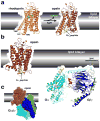The quest to understand heterotrimeric G protein signaling
- PMID: 20520658
- PMCID: PMC2954486
- DOI: 10.1038/nsmb0610-650
The quest to understand heterotrimeric G protein signaling
Abstract
Over the past fifteen years, great strides have been made to understand how heterotrimeric G proteins control their downstream targets. However, the mechanism by which heterotrimeric G proteins are activated by their upstream G protein-coupled receptors (GPCRs) remains obscure. Recent structural data support the idea that GPCRs, despite their small size, are sophisticated allosteric machines with multiple signaling outputs.
Figures


References
-
- Rall TW, Sutherland EW. The regulatory role of adenosine-3′, 5′-phosphate. Cold Spring Harb Symp Quant Biol. 1961;26:347–54. - PubMed
-
- Hepler JR, Gilman AG. G proteins. Trends Biochem Sci. 1992;17:383–7. - PubMed
-
- Sprang SR, Chen Z, Du X. Structural basis of effector regulation and signal termination in heterotrimeric G proteins. Adv Protein Chem. 2007;74:1–65. - PubMed
Publication types
MeSH terms
Substances
Grants and funding
LinkOut - more resources
Full Text Sources
Miscellaneous

